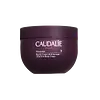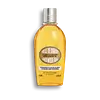What's inside
What's inside
 Key Ingredients
Key Ingredients

 Benefits
Benefits

 Concerns
Concerns

 Ingredients Side-by-side
Ingredients Side-by-side

Water
Skin ConditioningCoco-Caprylate/Caprate
EmollientGlycerin
HumectantVitis Vinifera Seed Oil
EmollientButyrospermum Parkii Butter Extract
Skin ConditioningButylene Glycol
HumectantHexyldecyl Stearate
EmollientIsocetyl Stearate
EmollientOctyldodecyl Myristate
EmollientArachidyl Alcohol
EmollientGlyceryl Stearate
EmollientPalmitoyl Grape Seed Extract
Skin ConditioningBehenyl Alcohol
EmollientPalmitic Acid
EmollientStearic Acid
CleansingArachidyl Glucoside
EmulsifyingPentaerythrityl Distearate
EmulsifyingPolyacrylate Crosspolymer-6
Emulsion StabilisingCaprylyl Glycol
EmollientEthylhexylglycerin
Skin ConditioningSodium PCA
HumectantPotassium Sorbate
PreservativeXanthan Gum
EmulsifyingLimonene
PerfumingTocopherol
AntioxidantHelianthus Annuus Seed Oil
EmollientLinalool
PerfumingIris Florentina Root Extract
MaskingCitric Acid
BufferingGeraniol
PerfumingSodium Phytate
Parfum
MaskingCitral
PerfumingWater, Coco-Caprylate/Caprate, Glycerin, Vitis Vinifera Seed Oil, Butyrospermum Parkii Butter Extract, Butylene Glycol, Hexyldecyl Stearate, Isocetyl Stearate, Octyldodecyl Myristate, Arachidyl Alcohol, Glyceryl Stearate, Palmitoyl Grape Seed Extract, Behenyl Alcohol, Palmitic Acid, Stearic Acid, Arachidyl Glucoside, Pentaerythrityl Distearate, Polyacrylate Crosspolymer-6, Caprylyl Glycol, Ethylhexylglycerin, Sodium PCA, Potassium Sorbate, Xanthan Gum, Limonene, Tocopherol, Helianthus Annuus Seed Oil, Linalool, Iris Florentina Root Extract, Citric Acid, Geraniol, Sodium Phytate, Parfum, Citral
Vitis Vinifera Seed Oil
EmollientTipa-Laureth Sulfate
CleansingLaureth-3
EmulsifyingCaprylic/Capric Triglyceride
MaskingParfum
MaskingCocamide Mea
EmulsifyingPropylene Glycol
HumectantSorbitan Oleate
EmulsifyingPrunus Amygdalus Dulcis Oil
Skin ConditioningCitrus Aurantium Bergamia Fruit Oil
MaskingHelianthus Annuus Seed Oil
EmollientRosmarinus Officinalis Leaf Extract
AntimicrobialTocopherol
AntioxidantWater
Skin ConditioningLimonene
PerfumingCoumarin
PerfumingLinalool
PerfumingVitis Vinifera Seed Oil, Tipa-Laureth Sulfate, Laureth-3, Caprylic/Capric Triglyceride, Parfum, Cocamide Mea, Propylene Glycol, Sorbitan Oleate, Prunus Amygdalus Dulcis Oil, Citrus Aurantium Bergamia Fruit Oil, Helianthus Annuus Seed Oil, Rosmarinus Officinalis Leaf Extract, Tocopherol, Water, Limonene, Coumarin, Linalool
 Reviews
Reviews

Ingredients Explained
These ingredients are found in both products.
Ingredients higher up in an ingredient list are typically present in a larger amount.
Helianthus Annuus Seed Oil is the oil derived from the seeds of a Sunflower. Sunflower seed oil is non-fragrant. It is an emollient, meaning it helps to soften the skin.
Sunflower seed oil contains many fatty acids. The fatty acids found in sunflower seeds include (from highest amount to least): linoleic acid, myristic acid, palmitic acid, stearic acid, arachidic acid, oleic acid, and linolenic acid.
These fatty acids help the skin create ceramides. Ceramides play a role in repairing the skin barrier.
Helianthus Annuus Seed Oil helps moisturize the skin. This in turn helps the skin look more rejuvenated and smoother.
Sunflowers are rich in vitamin E.
Historians believe Indigenous cultures of North America domesticated sunflowers before corn. Thus they relied on sunflower oil for a variety of uses. One such use is moisturizing skin and hair.
Sunflower seed oil may not be fungal acne safe. We recommend speaking with a professional if you have any concerns.
Learn more about Helianthus Annuus Seed OilLimonene is a fragrance that adds scent and taste to a formulation.
It's found in the peel oil of citrus fruits and other plants such as lavender and eucalyptus. The scent of limonene is generally described as "sweet citrus".
Limonene acts as an antioxidant, meaning it helps neutralize free radicals.
When exposed to air, oxidized limonene may sensitize the skin. Because of this, limonene is often avoided by people with sensitive skin.
The term 'fragrance' is not regulated in many countries. In many cases, it is up to the brand to define this term. For instance, many brands choose to label themselves as "fragrance-free" because they are not using synthetic fragrances. However, their products may still contain ingredients such as essential oils that are considered a fragrance.
Learn more about LimoneneLinalool is a fragrance and helps add scent to products. It's derived from common plants such as cinnamon, mint, citrus, and lavender.
Like Limonene, this ingredient oxidizes when exposed to air. Oxidized linalool can cause allergies and skin sensitivity.
This ingredient has a scent that is floral, spicy tropical, and citrus-like.
Learn more about LinaloolParfum is a catch-all term for an ingredient or more that is used to give a scent to products.
Also called "fragrance", this ingredient can be a blend of hundreds of chemicals or plant oils. This means every product with "fragrance" or "parfum" in the ingredients list is a different mixture.
For instance, Habanolide is a proprietary trade name for a specific aroma chemical. When used as a fragrance ingredient in cosmetics, most aroma chemicals fall under the broad labeling category of “FRAGRANCE” or “PARFUM” according to EU and US regulations.
The term 'parfum' or 'fragrance' is not regulated in many countries. In many cases, it is up to the brand to define this term.
For instance, many brands choose to label themselves as "fragrance-free" because they are not using synthetic fragrances. However, their products may still contain ingredients such as essential oils that are considered a fragrance by INCI standards.
One example is Calendula flower extract. Calendula is an essential oil that still imparts a scent or 'fragrance'.
Depending on the blend, the ingredients in the mixture can cause allergies and sensitivities on the skin. Some ingredients that are known EU allergens include linalool and citronellol.
Parfum can also be used to mask or cover an unpleasant scent.
The bottom line is: not all fragrances/parfum/ingredients are created equally. If you are worried about fragrances, we recommend taking a closer look at an ingredient. And of course, we always recommend speaking with a professional.
Learn more about ParfumTocopherol (also known as Vitamin E) is a common antioxidant used to help protect the skin from free-radicals and strengthen the skin barrier. It's also fat soluble - this means our skin is great at absorbing it.
Vitamin E also helps keep your natural skin lipids healthy. Your lipid skin barrier naturally consists of lipids, ceramides, and fatty acids. Vitamin E offers extra protection for your skin’s lipid barrier, keeping your skin healthy and nourished.
Another benefit is a bit of UV protection. Vitamin E helps reduce the damage caused by UVB rays. (It should not replace your sunscreen). Combining it with Vitamin C can decrease sunburned cells and hyperpigmentation after UV exposure.
You might have noticed Vitamin E + C often paired together. This is because it is great at stabilizing Vitamin C. Using the two together helps increase the effectiveness of both ingredients.
There are often claims that Vitamin E can reduce/prevent scarring, but these claims haven't been confirmed by scientific research.
Learn more about TocopherolVitis Vinifera Seed Oil comes from the grape vine. Grape seeds are a byproduct of creating grape juice or wine.
The components of grape seeds have many skin benefits. Research has found it to be antimicrobial and anti-inflammatory. It also contains many potent antioxidants such as Vitamin E , Vitamin C, proanthocyanidins, polyphenols, flavonoids, and anthocyanins. Proanthocyanidin has been shown to help even out skin tone.
Antioxidants help fight free-radical molecules. Free-radical molecules are capable of damaging our cells and other genetic material. Antioxidants help stabilize free-radicals by donating extra electrons. Grape seed extract may help reduce the signs of aging.
The antimicrobial properties of grape seed may help treat acne. However, more research is needed to support this claim.
Grape seed has also been found to help absorb UV rays. Grape seed extract should not replace your sunscreen.
The fatty acids of grape seed oil give it emollient properties. Emollients help soothe and soften your skin by creating a film. This film traps moisture within, keeping your skin hydrated.
Learn more about Vitis Vinifera Seed OilWater. It's the most common cosmetic ingredient of all. You'll usually see it at the top of ingredient lists, meaning that it makes up the largest part of the product.
So why is it so popular? Water most often acts as a solvent - this means that it helps dissolve other ingredients into the formulation.
You'll also recognize water as that liquid we all need to stay alive. If you see this, drink a glass of water. Stay hydrated!
Learn more about Water